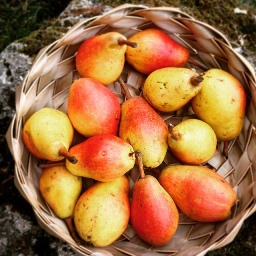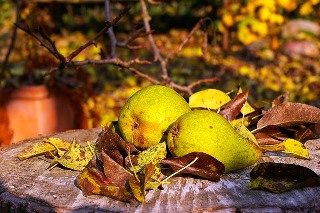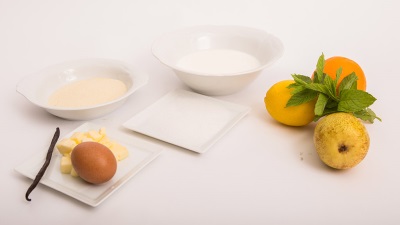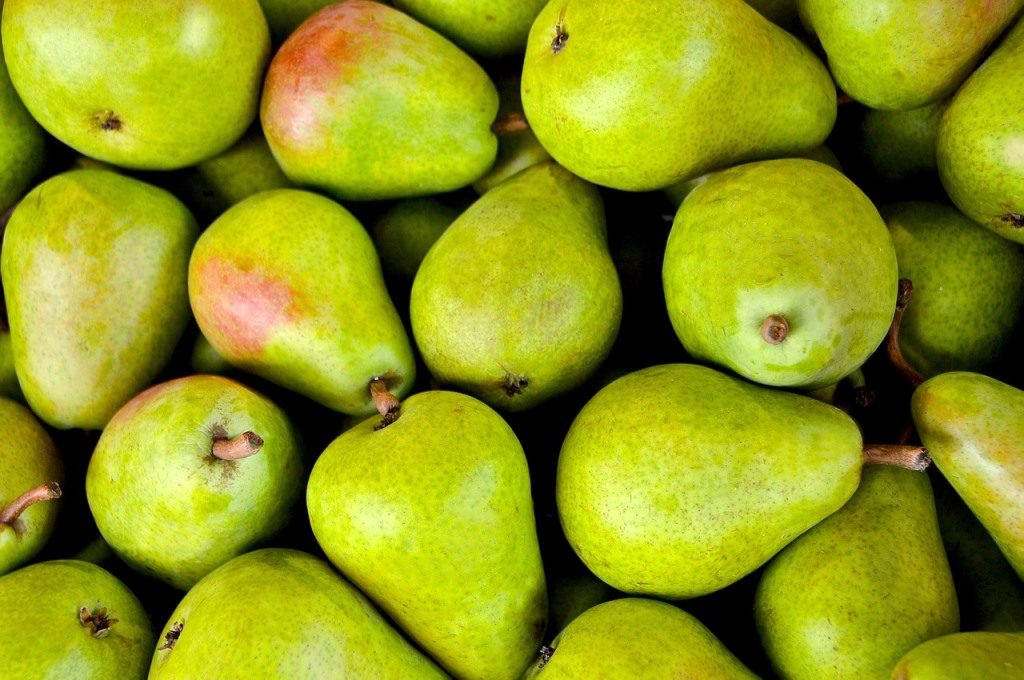 Like apples (lat.: Malus), pears belong to the Malinae subtribe within the rose family (Rosaceae). By comparison with apples, there are only approximately half as many types of pears [1]. Even so, this still constitutes quite a number of varieties. The diversity of apple and pear varieties, however, is continually decreasing. In 1880 there were more than 20,000 apple varieties around the world but today the number has fallen to some 4,500. With regard to varieties which are of economic importance, there are only approximately 60 varieties – and the trend indicates further decline [2]. For this reason programmes such as the “Deutsche Genbank Obst” (German gene bank for fruit crops) have been created. This gene bank collects and sustains genetic resources and consequently preserves the diversity of varieties [3]. In Germany, the best known pear varieties are Conference, Abate Fétel, Alexander Lucas and Williams Christ.
Like apples (lat.: Malus), pears belong to the Malinae subtribe within the rose family (Rosaceae). By comparison with apples, there are only approximately half as many types of pears [1]. Even so, this still constitutes quite a number of varieties. The diversity of apple and pear varieties, however, is continually decreasing. In 1880 there were more than 20,000 apple varieties around the world but today the number has fallen to some 4,500. With regard to varieties which are of economic importance, there are only approximately 60 varieties – and the trend indicates further decline [2]. For this reason programmes such as the “Deutsche Genbank Obst” (German gene bank for fruit crops) have been created. This gene bank collects and sustains genetic resources and consequently preserves the diversity of varieties [3]. In Germany, the best known pear varieties are Conference, Abate Fétel, Alexander Lucas and Williams Christ.
The pear originates from Anatolia and Caucasus, and today it is grown across the whole of Europe, Asia and North Africa [4]. The Latin name of Pyrus was introduced in the work “Species Plantarum” by Swedish naturalist Carl von Linné, published in 1753 (see picture). von Linné is known as the originator of the scientific nomenclature system which is still used today in botany and zoology.
Health and nutrition
 Due to the lower acid content of pears, they are often much easier to digest than other pome fruit. This makes them particularly suitable for patients with stomach problems or similar problems. As with many types of pome fruit, in pears the majority of the beneficial constituents are found beneath the skin. Where possible, try to buy varieties which have not been treated with pesticides and eat with the skin on.
Due to the lower acid content of pears, they are often much easier to digest than other pome fruit. This makes them particularly suitable for patients with stomach problems or similar problems. As with many types of pome fruit, in pears the majority of the beneficial constituents are found beneath the skin. Where possible, try to buy varieties which have not been treated with pesticides and eat with the skin on.
Pears are just as low in calories as apples (see “An apple a day keeps the doctor away“) but actually contain even more fibre than apples. Pears also beat their close relatives in terms of folic acid, calcium and magnesium content. Apples, in contrast, contain more vitamin C, vitamin B6 and potassium [5].
Such a comparison of apples and pears clearly demonstrates how each type of food has its own important constituents. The best way of providing the body with many types of vitamins and minerals is to eat as broad a range as possible from across the entire spectrum of foods available. Eating a varied diet is therefore the first of 10 guidelines from the German Nutrition Society (DGE) for healthy eating: “Enjoy food diversity” [6]. No single food contains all of the nutrients we need which means they cannot keep us healthy as a sole source of nutrition.
 The high folic acid content in pears is known by women as the vitamin taken during pregnancy to protect against neural tube defects. Folic acid is required for the normal process of cell division [7]. In oncology, folic acid is given a great deal of attention because of a variety of medicines which interfere with the metabolism of this nutrient – for example, methotrexate and co-trimoxazole. Long-term use of these substances at a high dosage leads to a deficiency in folic acid. This is manifested in acute stomatitis and a specific type of anaemia (hyperchromic macrocyctic anaemia), which can be avoided by taking a supplement of the required amount of folic acid [8].
The high folic acid content in pears is known by women as the vitamin taken during pregnancy to protect against neural tube defects. Folic acid is required for the normal process of cell division [7]. In oncology, folic acid is given a great deal of attention because of a variety of medicines which interfere with the metabolism of this nutrient – for example, methotrexate and co-trimoxazole. Long-term use of these substances at a high dosage leads to a deficiency in folic acid. This is manifested in acute stomatitis and a specific type of anaemia (hyperchromic macrocyctic anaemia), which can be avoided by taking a supplement of the required amount of folic acid [8].
In the kitchen
When buying pears, make sure that the pears are just a little soft when pressed. Fruit should be stored in a cool, dry place. As is the case with apples, pears very quickly oxidise upon contact with air and therefore brown in a short space of time. Bear this in mind when preparing them. To help prevent this browning, use a little lemon juice.
 There are two types of pears: eating and cider (perry) pears. Cider pears are used to make pear schnapps, for example. Eating pears are the type we eat and cook with and can be used, for example, to make pear compote or purée as well as delicious desserts. A well-known dessert using pears is ‘Poire belle Hélène’. Pears can also be integrated in savoury dishes such as game or fish recipes. They are also extremely tasty in salads or paired with cheese plates. At Christmas pears are used in Germany to bake the famous ‘Kletzenbrot’ – a type of fruit bread.
There are two types of pears: eating and cider (perry) pears. Cider pears are used to make pear schnapps, for example. Eating pears are the type we eat and cook with and can be used, for example, to make pear compote or purée as well as delicious desserts. A well-known dessert using pears is ‘Poire belle Hélène’. Pears can also be integrated in savoury dishes such as game or fish recipes. They are also extremely tasty in salads or paired with cheese plates. At Christmas pears are used in Germany to bake the famous ‘Kletzenbrot’ – a type of fruit bread.
 Soon we will be posting a tasty pear recipe on our blog, created exclusively for the Munich Tumour Centre by Herbert Hintner. This blog post was written in collaboration with the oncological nutritional therapy team at the Comprehensive Cancer Center (LMU Großhadern, Ms A. Hopp).
Soon we will be posting a tasty pear recipe on our blog, created exclusively for the Munich Tumour Centre by Herbert Hintner. This blog post was written in collaboration with the oncological nutritional therapy team at the Comprehensive Cancer Center (LMU Großhadern, Ms A. Hopp).
Sources:
[1] Germplasm Resources Information Network (GRIN), U.S. National Plant Germplasm System, National Genetic Resources Program. National Germplasm Resources Laboratory, Beltsville, Maryland, https://npgsweb.ars-grin.gov/gringlobal/taxonomygenus.aspx?id=10194 [Zugriff am 16 11 2017].
[2] K. Knoche-Weniger, M. Weniger, Slow Food Deutschland e.V.: Geschmacks- und Sortenvielfalt erleben – Unser Apfel, https://www.slowfood.de/slow_food_vor_ort/essen/termine_2013/termine_2014/14_10_20_schneckentisch_10_2014/20141020_st_apfel/ [Zugriff am 16 11 2017].
[3] B. f. K. Julius Kühn-Institutes: Deutsche Genband Obst – Vielfalt bewahren, http://www.deutsche-genbank-obst.de/site/index. [Zugriff am 16 11 2017].
[4] H. Kutzelnigg, Pyrus. In: Hildemar Scholz (Hrsg.): Illustrierte Flora von Mitteleuropa. Begründet von Gustav Hegi. Band IV Teil 2B: Spermatophyta: Angiospermae: Dicotyledones 2 (3) (Rosaceae, 2. Teil), Berlin/Wien: Blackwell, 1995.
[5] H. Heseker, B. Heseker: Nährstoffe in Lebensmitteln – Die große Energie- und Nährwerttabelle, Sulzbach im Taunus: Umschau Zeitschriftenverlag, 2013.
[6] Deutsche Gesellschaft für Ernährung e.V.: Vollwertig essen und trinken nach den 10 Regeln der DGE, http://www.dge.de/ernaehrungspraxis/vollwertige-ernaehrung/10-regeln-der-dge/. [Zugriff am 16 11 2017].
[7] H. K. Biesalski, P. Grimm, S. Nowitzki-Grimm: Taschenatlas der Ernährung, Stuttgart: Georg Thieme Verlag, 2015.
[8] H. Berzt, G. Zürcher: Ernährung in der Onkologie – Grundlage und klinische Praxis, Stuttgart: Schattauer Verlag, 2014.
